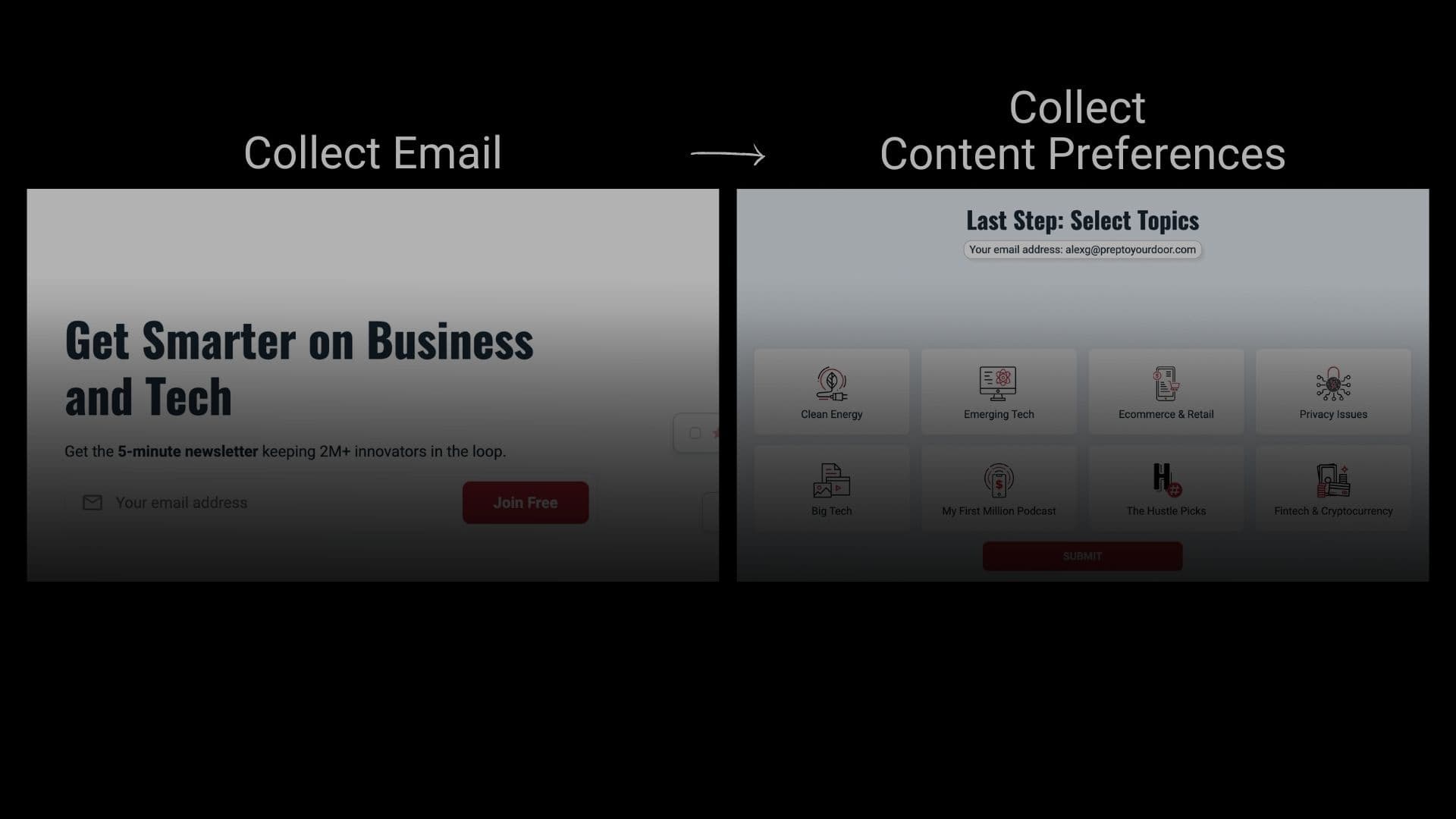Your Zero-Party Data Playbook
First, let’s set the definition. What is zero-party data?
According to Forrester's research, zero-party data is data that a customer intentionally and proactively shares with a brand.
In other words, this data isn’t the result of a pixel (like Facebook’s, TikTok’s, or third-party pixels like Triple Whale) following your customer around the internet.
The Founder and CEO of Octane Ai say, “With zero-party data, brands are significantly diminishing their dependence on third-party advertisers and building meaningful relationships based on personalization and trust. Building a relationship isn’t just collecting email addresses or phone numbers; it’s about getting to know each customer’s preferences, needs, and pain points.”
This data is voluntarily handed over to your brand via mechanisms like quiz funnels, post-purchase surveys, or even customer interviews.
Here’s an image that further illustrates the difference between zero-party data, first-party data, second-party data, and third-party data:
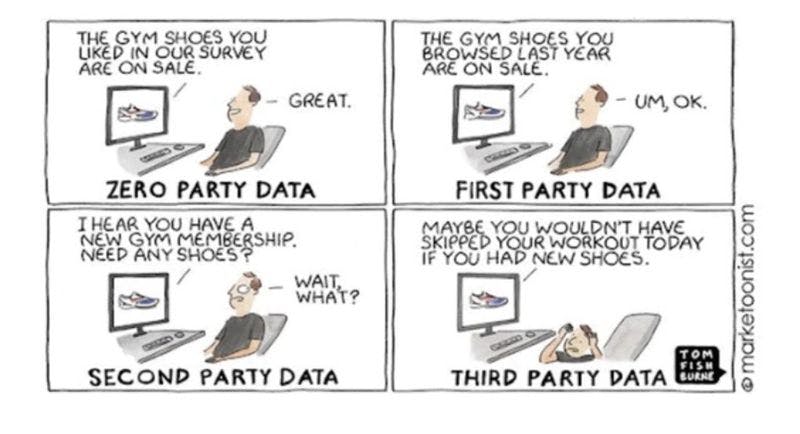
And by collecting zero party data we can deliver more personalized:
- Content
- Campaigns
- Messaging
- Shopping Experience
Now let’s walk through each of the use-cases for this type of data:
Create Better Content By Using Zero-Party Data
A problem all media companies face at scale: a segmented audience.
While possible, it’s unlikely that your entire audience prefers the exact same type of content.
And if you use “traditional” content distribution platforms, you’re sacrificing the performance of that content.
Why?
You’re feeding a % of your audience content that they don’t like. Thus, lower open rates, lower engagement... and slower growth.
By collecting zero-party data, you can make sure each individual in your audience gets content tailored to their preferences.
Here’s an example:
The Hustle is a business and tech newsletter with over 1.5M subscribers. At that scale (with a niche as broad as ‘business and tech’), audience segmentation becomes a real problem.
Someone interested in crypto news might not give a crap about eCommerce and retail businesses.
If said crypto-bro sees an eCommerce-related subject line in his inbox... he ain’t opening.
The fix?
This screen:
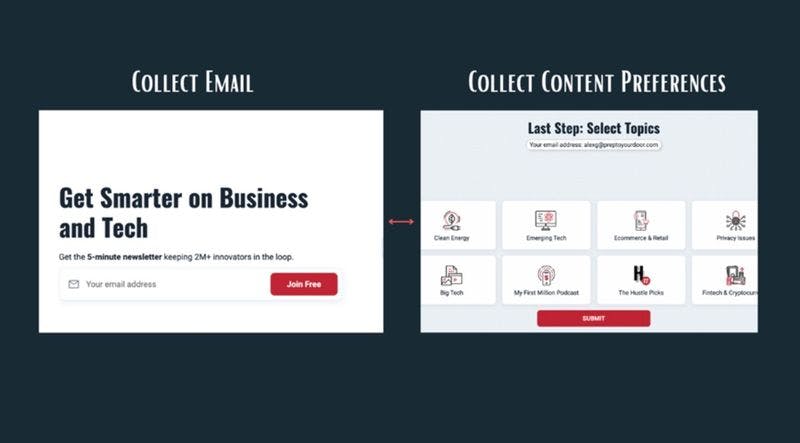
When the sub chooses the topic, they are put into buckets that ensure they only get content relevant to their interests.
The result:
- Higher open rates
- Lower Churn
- Better Reader Experience
Another similar example of this is Workweek.
Workweek is a new kind of media company with several creators under its umbrella.
They cover a wider variety of topics than The Hustle, making zero-party data collection even more important.
Workweek collects zero-party data post subscription.
Example:
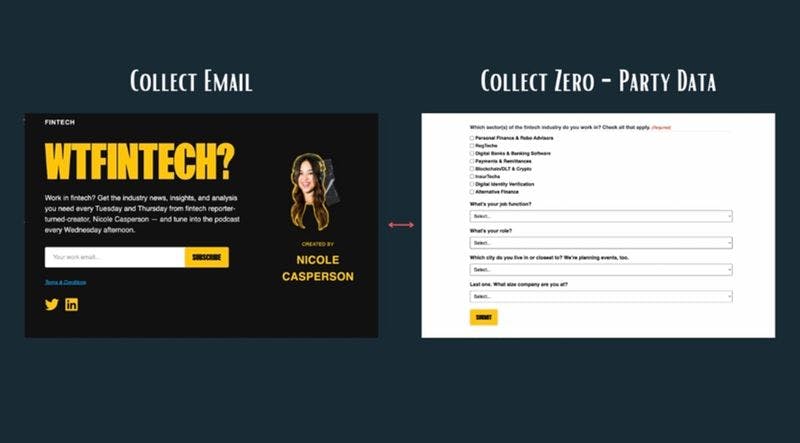
This helps them do two things:
- Personalize The Content
- Find and Sell Sponsorships
They’re able to tailor the content based on the replies.
And they can go to potential sponsors with clear data on who reads each of their newsletters — allowing companies to reach their ideal customers with confidence (and likely charging more for placements as a result).
This is still applicable even if you’re not a media company.
Because many companies are building a media arm in conjunction with their existing business.
That media arm can now be influenced and steered based on zero-party data.
Improve Your Email and SMS Marketing By Using Zero-Party Data
You can use the same logic as above to boost the performance of your owned marketing channels: email and SMS.
Just like newsletter consumers have different interests that influence open rates, your e-commerce or SaaS prospects have:
- Different product interests
- Different feature interests
- Different ideal outcomes
- Different pain points that trigger purchases
And a traditional approach to email marketing will leave you with lower open rates and a customer experience with room for improvement.
Collecting zero-party data for your ecomm store will help you recommend the right product to your prospect and write subject lines/content that better resonates with them.
In e-commerce, this often looks like a quiz funnel.
A great example of this in action is Jones Road Beauty.
They have a quiz that helps prospects find the right product for them on their site.
Example:
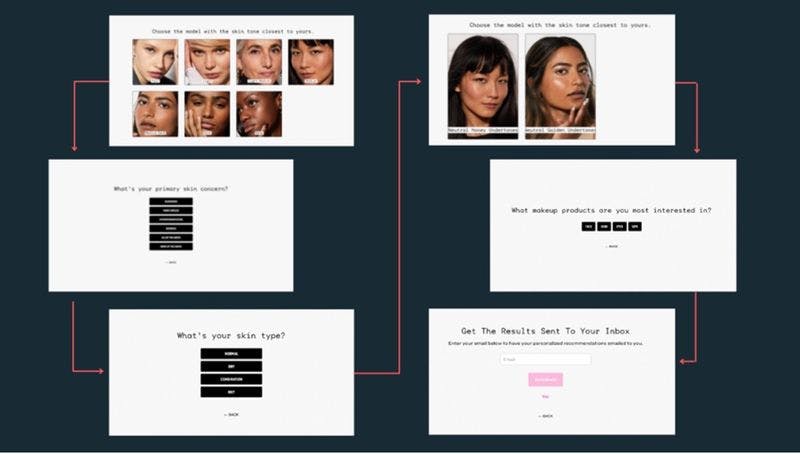
Two things happen here:
- Jones Road Beauty personalizes the shopping experience based on pain points
- Jones Road Beaty builds a massive email list that's segmented
It not only informs owned marketing channels but also guides advertising angles across organic and paid channels (like TikTok ads). We’ll discuss this in the next section, so keep reading.
After completing the quiz, the prospect is prompted to enter their email in exchange for the results.
Once on the email list, JRB likely has automated flows in place based on the:
- Skin type
- Pain points
- Product preferences
This way, customers aren’t getting their inboxes blown up by irrelevant content and promotions.
The result?
Higher open rates, click-through rates, and ultimately...more purchases.
Check this out: Their zero-party data quiz lead to their AOV jumping from $60 to $90 dollars and has a conversion rate of 16%.
And at the end of the day, this TikTok ads + quiz funnel has netted JRB 7 figures in profit...
Not too shabby.
I know what you’re thinking:
But doesn’t a long quiz just add extra steps to the funnel? Won’t I lose prospects?
Maybe. But here’s the thing: friction isn’t ‘bad.’
Often, the benefit of the data you collect during this process will outweigh the extra friction it takes to gather it.
Play the long game.
The impact of zero-party data isn’t limited to owned channels.
You can also use it to guide advertising decisions and acquire customers for less.
Lower Customer Acquisition Costs by Using Zero-Party Data
Let’s keep running with the Jones Road Beauty example.
Full transparency, this ‘example’ is somewhat speculation, but stick with me here.
Remember their quiz?
Imagine this scenario:
When you look at the quiz data, you see that a disproportionate amount of prospects select ‘dark circles’ as an issue of concern.
And a low amount of prospects select ‘redness.’
Does it make sense to pour money into ads with redness as the main pain point?
Nope — especially if you’re working with a limited marketing budget.
Instead, here’s what I’d do:
Prioritize testing TikTok ad angles and creatives with solving ‘dark circles’ as the main hook.
Deprioritize ads with ‘redness’ as the focus.
The audience told JRB what resonated with them.
You can collect this same data for your brand — and use it to make better ads and acquire customers at a lower cost.
Because here’s the thing — with zero-party data, you will discover:
- New audiences
- New pain points
- New value propositions
So, not only do you personalize your communication, but it’s equally as effective in improving your conversion rate.
Hence — altering your landing pages based on zero-party data.
Boost Landing Page Conversion Rate by Using Zero-Party Data
Remember: your landing page should feel like a red carpet experience.
The collection of zero-party data makes this possible.
Zero-party data will influence:
- The Headline (Main Value Proposition)
- The Creative
- The Copy
- The Benefits/Features
- The Social Proof
So, returning to the JRB example.
Based on the quiz response...
Let's say the customer's pain point is: eliminating dark circles
The product they're looking for is: Miracle Balm
BUT they never purchased.
So, now you're retargeting ads to educate the prospect on how the Miracle Balm eliminates dark circles...
Your email and SMS are tailored to this pain point and product.
Your landing page is created specifically for the Miracle Balm.
Your headline should attack dark circles as a pain point.
Your bullet points and copy supports that.
Your social proof should be from users who used Miracle Balm or other products — to eliminate dark circles.
Your ‘us vs them’ chart should highlight how Miracle Balm compares to other products in getting rid of dark circles.
This makes buying a no-brainer for someone who is frustrated by persistent dark circles.
And you wouldn’t have this insight if it wasn’t for the zero-party data you collected.
Improve Your Attribution By Using Zero-Party Data
iOS 14 screwed so many businesses out of key attribution data.
This makes it so much harder to decide where to spend your ad dollars.
And you end up scaling the wrong ads, the wrong channels... and wasting money while you’re at it.
One way to solve this is by collecting zero-party data via a post-purchase survey.
It’s exactly how it sounds:
After a customer purchases your product, the survey asks them, “Where did you hear about us?”
And then, they can select whatever platform they remember hearing about your brand on.
Check out this super simple example from Hims:
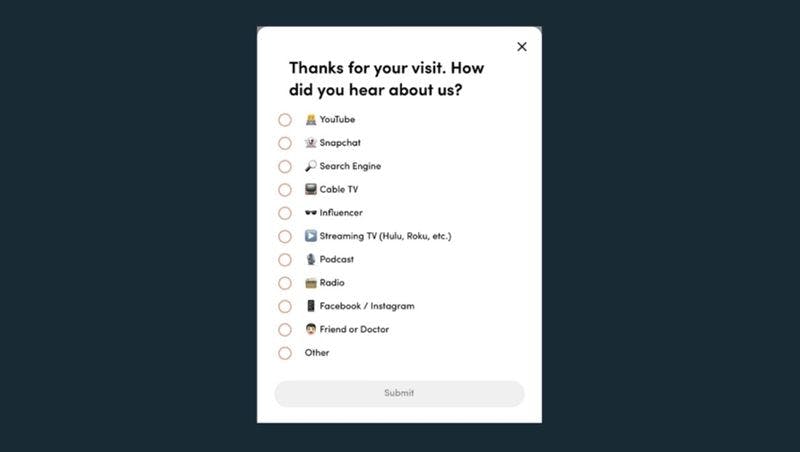
Your Zero-Party Data Next Steps
Ok, so where do you start?
At the most basic level, start with customer interviews.
Ask about:
- Preferences
- Pain Points
- Selling Points
- What they like/dislike
- Why you, instead of a competitor
- Why not a competitor
By collecting zero-party data firsthand with customers, you’ll be able to create better-tailored zero-party data touchpoints throughout the customer journey.
With this, you can now effectively collect zero-party data:
- Pre-purchase
- Quizzes
- Popups
- Questionaries
- Post Purchase
- Questionaries
- Email and SMS responses + flows
- Polls
